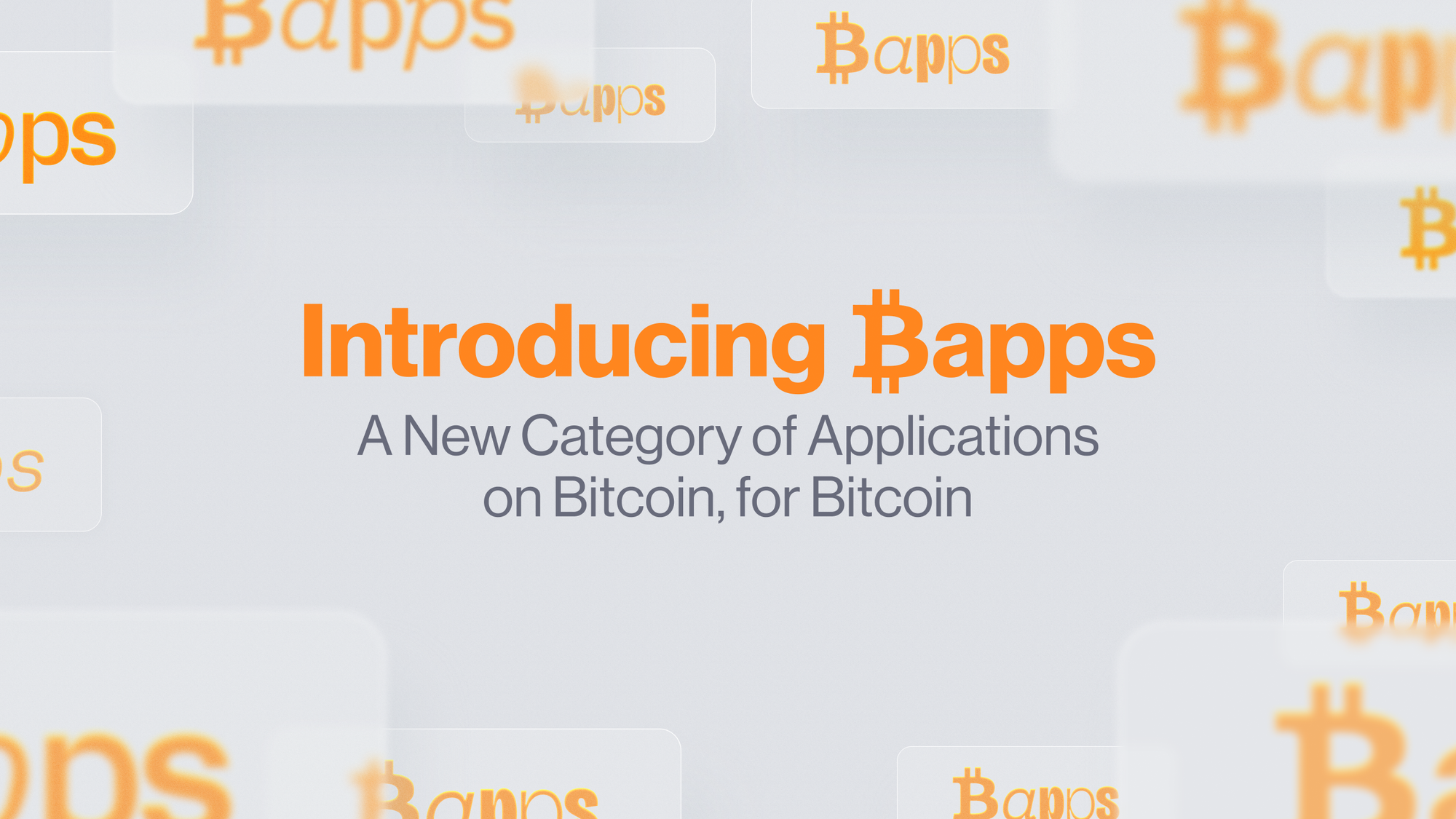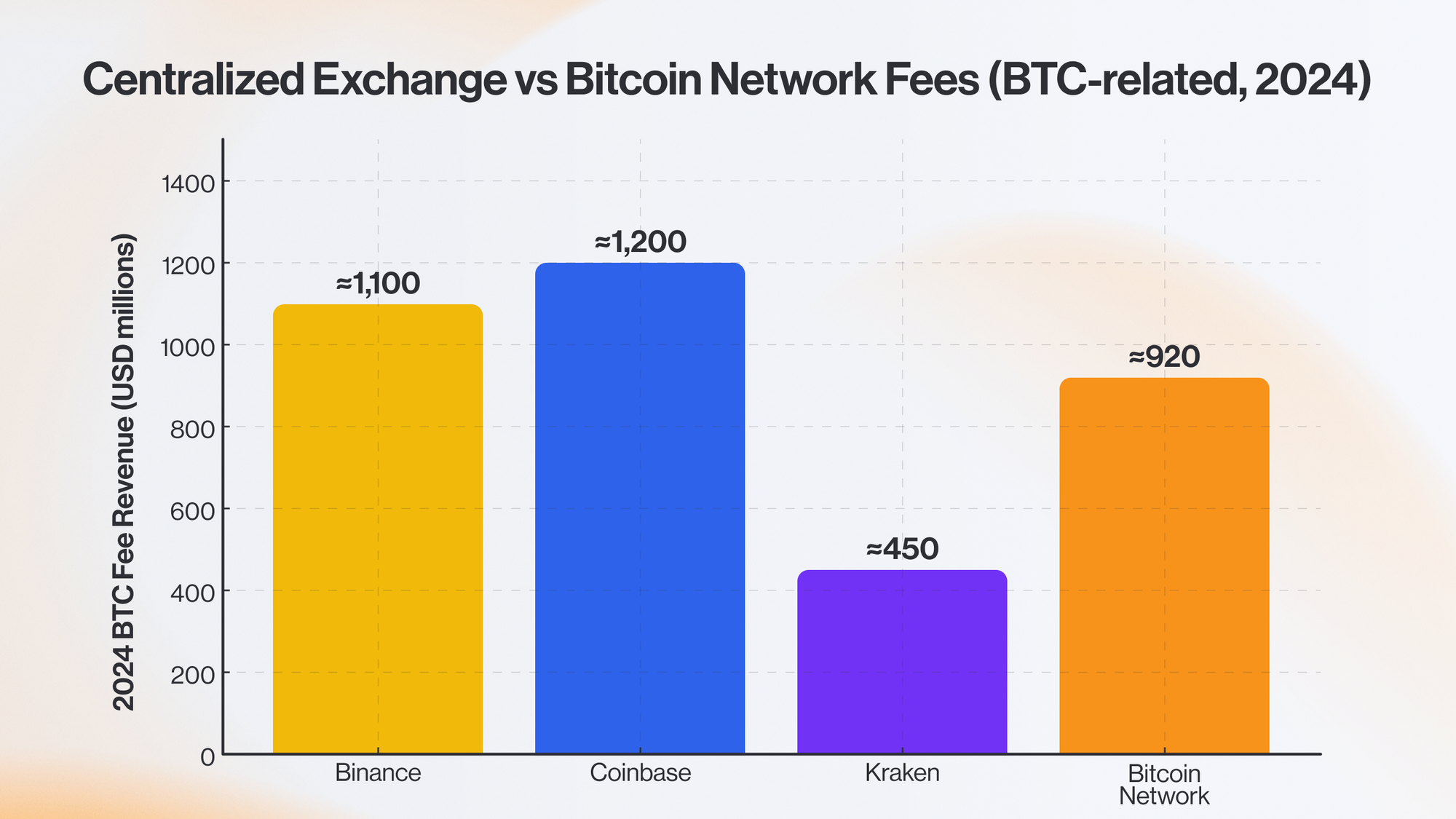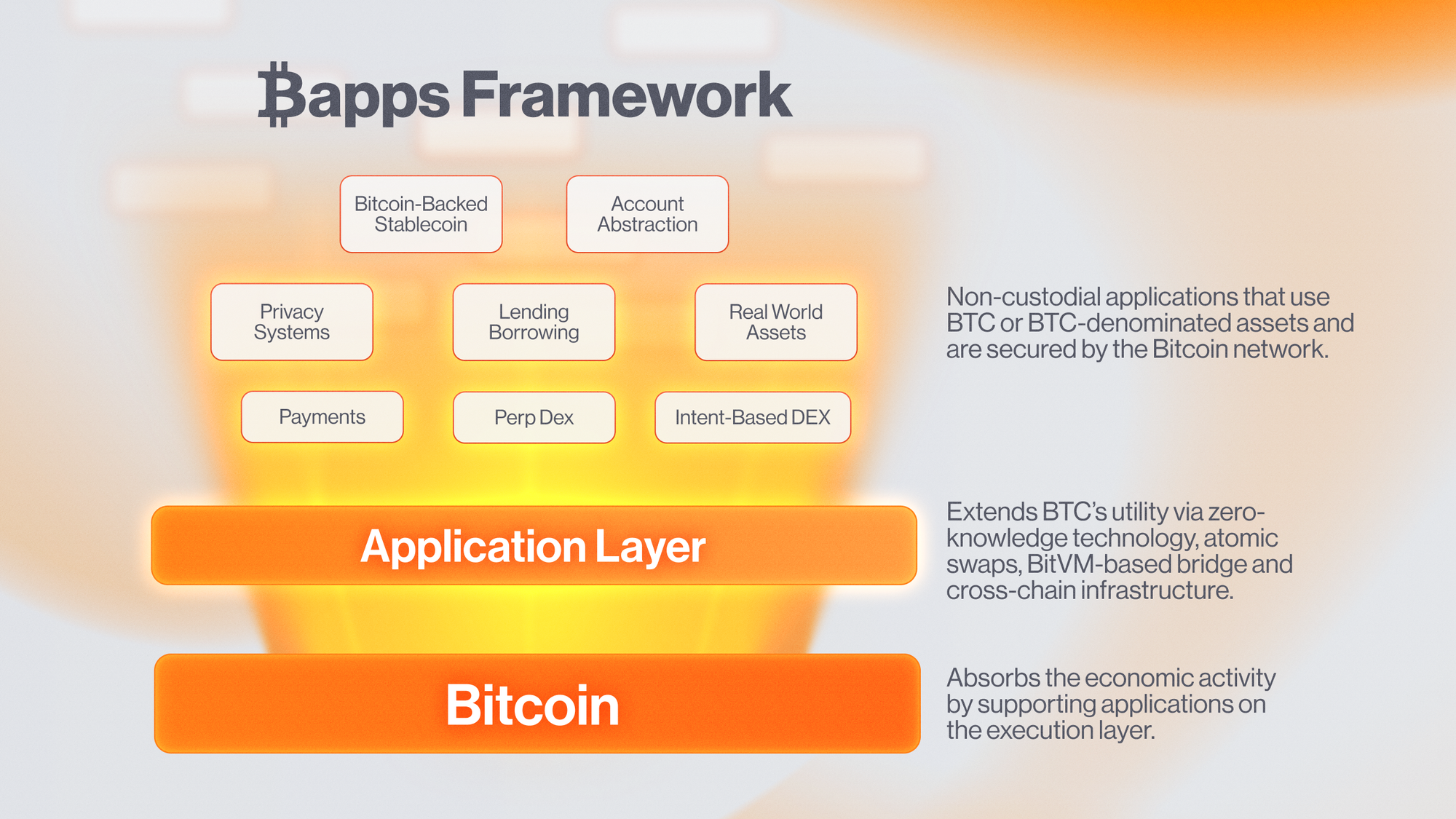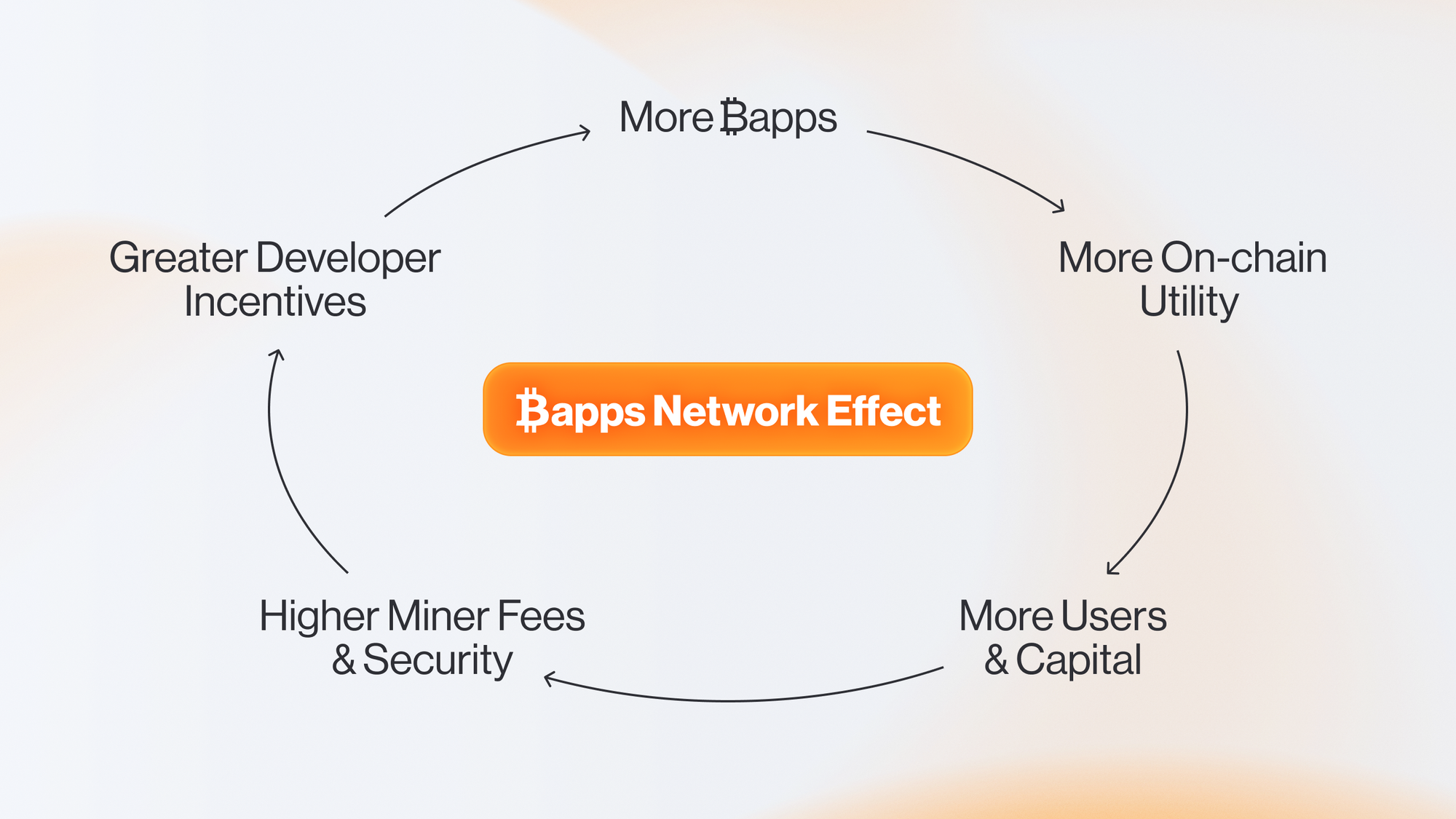A ₿app Manifesto

“We have proposed a system for electronic transactions without relying on trust.” - Satoshi Nakamoto, 2008.
Bitcoin was introduced as a liberating technology for borderless and censorship-resistant money. Yet in 2025, Bitcoin finds itself surrounded by custodians and increasingly treated as a passive store of value. The Bitcoin network is being sidelined, and its role in decentralized and censorship-resistant finance is being undermined.
This manifesto argues ₿apps will reverse this trend and reclaim Bitcoin’s value from centralized entities and other networks.
Today, centralized services and wrapped tokens dominate how BTC is used. BTC applications currently rely on multiple layers of intermediaries, extracting economic value from the Bitcoin network and handing it to other networks or middlemen:
- ≈ $2.8 billion in BTC trading fees flowed to major exchanges in 2024, ≈ 3× more than Bitcoin miners earned in transaction fees [1]
- ≈2.4 million BTC (≈11 % of supply) sit on centralized exchanges [2]
- ≈ 243,000 BTC (≈ 1.2 % of supply) circulate as wrapped tokens on other chains and exchanges [3]
It’s time for change.
The Problem: Value Drain from Bitcoin to Centralized Entities and Other Chains
Bitcoin was designed as a peer-to-peer electronic cash system, yet over time, its role has largely been reduced to a passive store of value. While the “digital gold” narrative has driven adoption, it has also left BTC locked away in wallets, most of them custodial, rather than fueling Bitcoin’s utility and a permissionless economy.
Meanwhile, decentralized finance (DeFi) has exploded, but Bitcoin has struggled to be part of it. Instead of being used directly, BTC has been wrapped and moved to other blockchains, or locked up in custodial solutions, where middlemen control access and introduce additional trust assumptions.
For years, BTC-based applications have not been built directly on Bitcoin. Instead, developers and users relied on:
- Wrapped BTC on independent chains, introducing counterparty risk.
- Custodial solutions, where users must trust third parties to hold their BTC.
- Centralized exchanges, where users may face loss or misuse of their funds and censorship.
This adoption path has real consequences. Instead of strengthening Bitcoin’s economy, wrapped BTC transactions and centralized entities benefit other blockchains and their intermediaries, pulling liquidity and activity away from Bitcoin itself.
Centralized exchanges collect billions of dollars from Bitcoin trading every year, often more than the Bitcoin network itself earns in miner fees. In 2024, just three exchanges processed roughly 3× more fees from Bitcoin trades than all Bitcoin miners earned in transaction fees for securing the network. [1]

The gap between the growing demand for Bitcoin and the lack of support for Bitcoin applications has caused:
- Liquidity drain: Major centralized venues processed ≈ $2.9 trillion of Bitcoin trading volume [4] in 2024, yet almost none of those transactions touched the Bitcoin network.
- Mindshare drain: On-chain economy primitives that Bitcoin pioneered are happening on other networks. These networks facilitate and collect billions in network fees for stablecoins, payments, and DeFi.
- Security risk: The more users rely on intermediaries for using Bitcoin in finance, the more the Bitcoin network itself is sidelined. This adoption path not only undermines Bitcoin’s role in decentralized finance but also jeopardizes the security and longevity of its network.
- Custodial risk: Users accept counter‑party, KYC, and censorship exposure, exactly what Bitcoin was meant to remove. The convenience and network effects of custodians created a walled garden that has been hard for purely self-custodial solutions to penetrate.
The Missing Piece Causing the Value Drain: No Infrastructure, No Ecosystem
The demand for Bitcoin-native applications has always existed. The problem? The infrastructure to support them simply wasn’t there.
Ethereum, for example, was originally conceived as a layer on Bitcoin before its creators realized that Bitcoin’s limitations made it impractical. Similarly, Augur, one of Ethereum’s earliest decentralized applications, was initially meant to be built on Bitcoin but had to migrate due to insufficient tooling and scalability constraints.
Without a foundation to build on, developers were isolated. There was no shared platform, no established best practices, and no easy way for Bitcoin-native applications to interact with each other. As a result, even when builders wanted to create on Bitcoin, they lacked the network effects necessary for adoption.
Again, this wasn’t a failure of demand. It was a failure of infrastructure.
The Turning Point: The Arrival of Bitcoin-Aligned Infrastructure and Builders
For the first time, Bitcoin doesn’t have to be left behind. The pressing need and demand for Bitcoin-native applications has significantly accelerated the builder movement in the last 5 years. This has been reflected in different research topics and experiments happening on Bitcoin. Builders started to explore Bitcoin-native assets (Ordinals, Runes, BRC-20s), applications with DLCs, building ZK rollups, and ways to verify complex computations directly on Bitcoin.
With the efforts of builders and researchers, best practices for building the right infrastructure for Bitcoin are being discussed. Infrastructure to connect different Bitcoin-native applications is being explored and builder network effects are being established. At Citrea, we’ve been doing our part and building the missing infrastructure to enable trust-minimized, non-custodial applications that bring value to Bitcoin.
By removing the need for wrapped BTC and custodians, Citrea and other ₿app builders extend Bitcoin’s utility without intermediaries and unnecessary trust assumptions.
The tools are here. The demand is here. The time to build is now.
Introducing ₿apps: Path to Hyperbitcoinization
Bitcoin can only win if it becomes the most widely used asset on-chain. The only way to drive broader adoption is to integrate Bitcoin into as many use cases as possible with minimal trust assumptions.
It’s time to redefine how we use Bitcoin. We must define what a Bitcoin application is.
₿app (noun): A non-custodial application that uses BTC or BTC-denominated assets and is secured by the Bitcoin network. ₿apps introduce a new category of applications that bring value to Bitcoin and BTC. Unlike past attempts, ₿apps directly inherit Bitcoin’s security, offering new possibilities for applications.
₿apps are powered by zero-knowledge technology, BitVM, atomic swaps, and cross-chain infrastructure.
The arrival of critical infrastructure makes ₿apps possible. An application layer secured by Bitcoin is possible with ZK proofs and infrastructure like Boundless that makes generating proofs secure, accessible, and affordable. BitVM-based bridge designs like Citrea’s Clementine extends BTC’s utility to ₿apps in a secure and trust-minimized way. Atomic swaps like Garden Finance and Atomiq Labs make interacting with the application layer trustless and peer-to-peer. Cross-chain infrastructure makes ₿apps accessible to different ecosystems.

₿apps are the ultimate funnel for on-chain Bitcoin economy.
Although this manifesto highlights the value drain from Bitcoin, there are promising signs that the tide is beginning to turn. Following a series of failures involving fund mismanagement, hacks, and data breaches, exchange balances have been dropping. To achieve funneling these users on-chain, Bitcoin needs high-quality applications, user-friendly and trustless bridges, and composability among the broader Bitcoin application ecosystem.
₿apps accelerate Bitcoin’s adoption as money. They enable use cases that the base layer alone can’t handle, making BTC liquid and readily available for everyday finance. While they enable on-chain Bitcoin financial primitives like BTC loans, fast payment systems, and decentralized exchanges, ₿apps can establish an on-chain Bitcoin economy where BTC is used for niche use cases such as buying on-chain real-world assets, betting, and gaming.
₿apps are modular and enable every BTC use case.
The vision of ₿apps is to make BTC accessible to all use cases. While Bitcoin’s security attracts users looking to leverage large amounts of capital during on-chain financial activities, offering different data availability options is crucial for supporting a diverse range of ₿apps and accelerating Bitcoin’s adoption as money. Data availability options like Celestia provide a secure and scalable path for high-performance ₿apps and ₿appchains. These modular ₿apps benefit from Citrea’s BTC liquidity and security while building highly scalable payment systems, games, or any other custom ₿apps.
₿apps network effect will dominate user, miner, developer, and capital mindshare.

Adding real on-chain use cases to Bitcoin will bring new users and liquidity on-chain. The more users contribute to the on-chain Bitcoin economy, the more sustainable Bitcoin’s monetary policy becomes. ₿apps will be the catalyst for hyperbitcoinization. People adopt the money they can earn, spend, borrow, and build on; ₿apps unlock every leg of that cycle.
Bitcoin gave us scarcity; ₿apps give us utility.
Build ₿apps, not intermediaries.
Methodology and Sources:
1. This calculation compares Coinbase, Binance, and Kraken BTC trading fees with Bitcoin miners’ transaction fees for 2024. Coinbase’s BTC revenue comes directly from Coinbase December 2024 10-K, page 143-94. Coinbase reports ≈$ 3.986B in total transaction revenue (page 143) and states BTC accounts for 30% of it (page 94). Please note that Binance and Kraken do not publicly publish asset-level revenue splits. Therefore, the methodology for BTC revenue share for Binance and Kraken takes Coinbase’s data for 30% as a publicly verifiable BTC revenue share percentage. Binance was reported to process approximately $7.35 trillion in total crypto trading volume in 2024. Based on its tiered fee schedule, a reasonable average effective fee for BTC trading on Binance was calculated around 0.05%. Applying Coinbase’s public BTC-share %, Bitcoin trading revenue is calculated to account for 30% of Binance’s total transaction revenue for 2024. Kraken’s BTC fees were calculated using its 2024 transparency report showing $1.5B revenue, and Coinbase’s 30% of BTC-share revenue. Miner transaction fee revenue is taken from Hashrate Index Bitcoin Mining Year-in-Review 2024, page 18. The dollar figure for miner transaction fee (≈ $920 million) is reproduced exactly from the report and is historical; it does not reflect today’s BTC-USD rate.
2. This figure, as of May, 2025, is based on data from CryptoQuant's Exchange Reserve metric, which tracks the total Bitcoin held in major centralized exchanges.
3. Represents the sum of WBTC, BTCB, cbBTC and tBTC circulating supply as of May, 2025.
4. Coinbase December 2024 10-K report (page 90, 92) records ≈ $1 trillion in trading volume, with BTC making up 32 %. Coingecko's report puts Binance at ≈ $7.3 trillion; applying Coinbase’s publicly available 32% BTC trading volume converts that to BTC volume. Kraken’s official report shows ≈ $665B in volume, and applying the same 32% ratio gives its BTC turnover.
This manifesto was originally published as an X article from Citrea's account on May 21, 2025. We have republished it on our blog for our subscribers.

